| System of Linear Inequalities |
|
|
| |
Some activities may require making graphs on paper. Click here to view and print graph paper, as needed.
For the first two problems, graph the given system of inequalities on graph paper, and then select the correct graph. |
|
|
| |
1) Which graph shows the solution (intersection) of the two given inequalities?
Hint: Solve the inequalities for y, if needed. Count out the slope (rise/run), locate the y-intercept (0, b) and test point (0, 0) for each inequality. The slope-intercept form of an equation is y = mx + b which is helpful in determining the boundary line of each inequality. |
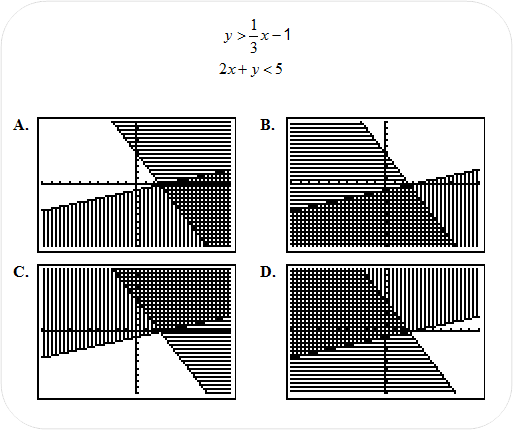 |
|
|
| |
|
2) Which graph shows the solution (intersection) of the two given inequalities?
Hint: Solve the inequalities for y, if needed. Count out the slope (rise/run), locate the y-intercept (0, b) and test point (0, 0) for each inequality. The slope-intercept form of an equation is y = mx + b which is helpful in determining the boundary line of each inequality. |
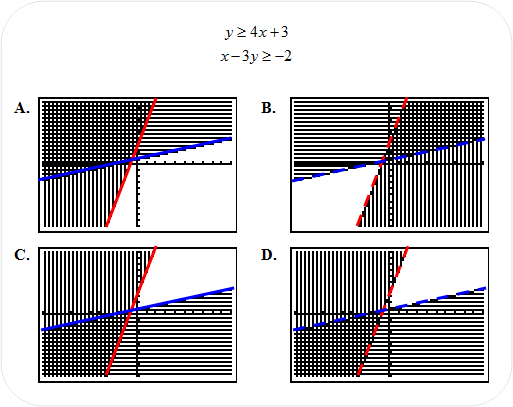 |
|
|
| |
|
| In the following problems, write a system of inequalities that matches the graph of the solution. |
|
|
| |
3) Which system of inequalities matches the graph of the solution?
Hint: Count out the slope (rise/run), locate the y-intercept (0, b) and test point (0, 0) for each inequality. The slope-intercept form of an equation is y = mx + b which is helpful in determining the boundary line of each inequality. |
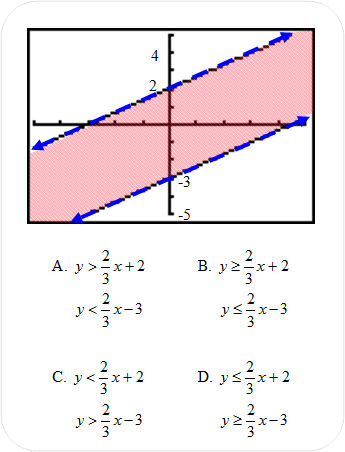 |
|
|
| |
|
4) Which system of inequalities matches the graph of the solution?
Hint: Count out the slope (rise/run), locate the y-intercept (0, b) and test point (0, 0) for each inequality. The slope-intercept form of an equation is y = mx + b which is helpful in determining the boundary line of each inequality. |
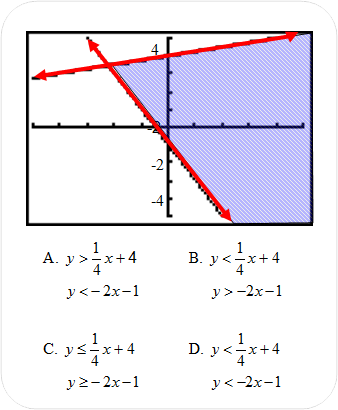 |
|
|
| |
|
| |
5) What are the coordinates of the vertices formed by the following linear system of inequalities?
Hint: Graph these vertical and horizontal inequalities. Find the vertices of the quadrilateral formed by the overlapping areas. |
 |
|
|
|
|
|
|
| |
|
6) What are the coordinates of the vertices formed by the following linear system of inequalities?
Hint: Graph these inequalities. Find the vertices of the quadrilateral formed by the overlapping areas.
|
 |
|
|
|
|
|
|
| |
|
7) The vertices of a feasible region are (0, 0), (0, 2.5), (3,1) and (2, 0). For which objective function is the maximum cost (C) found at the vertex (3, 1)?
Hint: Substitute x = 3 and y = 1 into each of the given equations. Find the equation that gives the maximum value. |
|
|
|
| |
|
8) A feasible region has vertices at (0, 1), (1, 3), (6, 3) and (10, 1). What are the maximum and minimum values for the objective function P = 3x + y?
Hint: Substitute each point into the objective function P. Find the point that gives the maximum value and the point that gives the minimum value. |
 |
|
|
| |
|
| In the following questions, use the given linear system of inequalities. |
 |
|
| |
9) What are the coordinates of the vertices of the feasible region?
Hint: Graph the given inequalities. Find the coordinates of the triangle formed by the overlapping areas. |
|
|
|
|
|
|
|
| |
|
10) What is the maximum value of P = x + 3y for the feasible region?
Hint: Substitute each of the x and y-values found in the previous problem and determine the maximum value that is produced. |
|
|
|
| |
|
11) What is the minimum value of P = x + 3y for the feasible region?
Look for the minimum value produced in the previous problem. |
|
|
|
| |
|
| Use the following scenario to answer the following questions: The high school football boosters sell student tickets for $4 and adult tickets for $6. The school officials reserve at least 500 tickets for students. The stadium seats 1200 people. |
 |
|
| |
12) If s represents the number of student tickets and a represents the number of adult tickets, which system of inequalities represents the number of tickets sold?
Hint: Build the inequalities based on the following highlighted statements:
The high school football boosters sell student tickets for $4 and adult tickets for $6. The school officials reserve at least 500 tickets for students. The stadium seats 1200 people.
|
 |
|
|
| |
|
13) What objective function can be used to find the maximum revenue (R), the amount of money collected on ticket sales? Note: For each type of ticket sold, revenue (R) equals the price of each ticket times the number of tickets.
Hint: Build the objective function based on the following highlighted statement:
The high school football boosters sell student tickets for $4 and adult tickets for $6. The school officials reserve at least 500 tickets for students. The stadium seats 1200 people. |
|
|
|
| |
|
14) How many adult tickets should be sold to maximize revenue? (Remember, at least 500 student tickets must be sold.)
Hint: Graph the inequalities determined for this problem. Find the coordinates of the triangle formed. Use the objective function to determine which point (s, a) gives the maximum revenue, and then answer the question asked. |
|
|
|
| |
|
| 15) What is the maximum revenue? |
|
|
|
| |
|
| |
16) Write an equation for the given slope that passes through the given point. Express the equation in slope-intercept form.
Click here to review the unit content explanation for Linear Equations. |
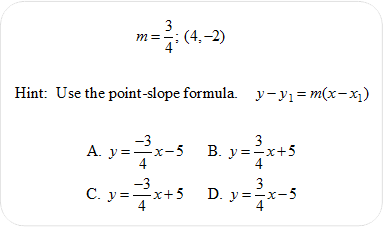 |
|
|
| |
|
17) Solve for y.
Hint: Use cross products.
Click here to review the unit content explanation for Solving Equations and Applications. |
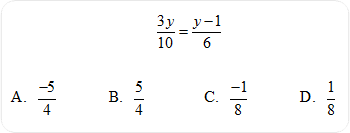 |
|
|
| |
|
18) Solve for x.
Hint: Make sure to distribute over both terms inside parenthesis when applying the distributive property.
Click here to review the unit content explanation for Solving Equations and Applications. |
 |
|
|
| |
|
19) State the domain and range of the following relation: {(–2, 12), (0, 8), (1, 9), (5, 3)}.
Click here to review the unit content explanation for Functions and Inverses of Functions. |
|
4000 character(s) left
Your answer is too long. |
|
| |
|
20) Evaluate the function given below for the following values: (a) x = –2, (b) x = 8.
Click here to review the unit content explanation for Functions and Inverses of Functions. |
 |
20000 character(s) left
Your answer is too long. |
|
|
Attachments |
|
21) What are the compositions of the given functions, f (x) and g (x), as directed in the problem?
Recall: When composing functions, substitute the expression of one function in for x in the other function as directed by the given composition.
Click here to review the unit content explanation for Functions and Inverses of Functions. |
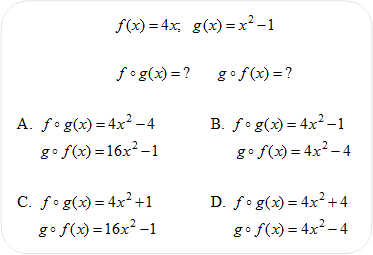 |
|
|
| |
|
22) Describe the transformation of the parent function (f (x)) transformed to the given function (g (x)). Include a description of the vertical stretch (a), the horizontal translation (h), the vertical translation (k), and the direction of the opening of the absolute value graph.
Hint: General form of an absolute value function: y = a|x – h| + k
Click here to review the unit content explanation for Special Functions and Transformations. |
 |
4000 character(s) left
Your answer is too long. |
|
|
Attachments |
|
| |
|
| 24) If you were directed by your school to complete Offline Activities for this course, please enter the information on the Log Entry form. |
|
| No offline activities found |
0 Hour(s) & 0 Minute(s)
|
|
|
Attachments |
|
|